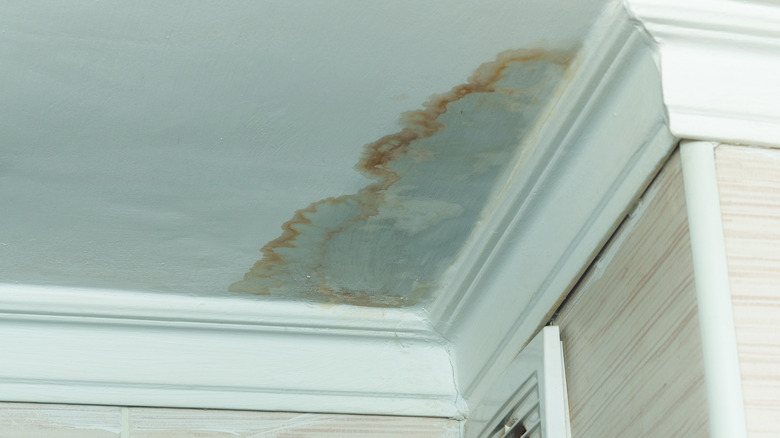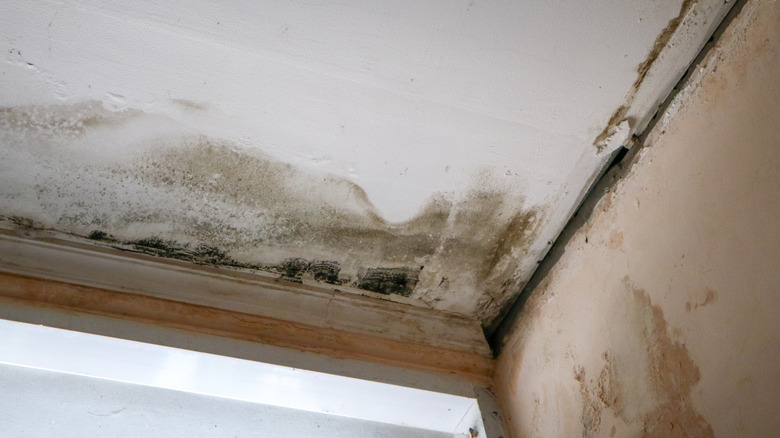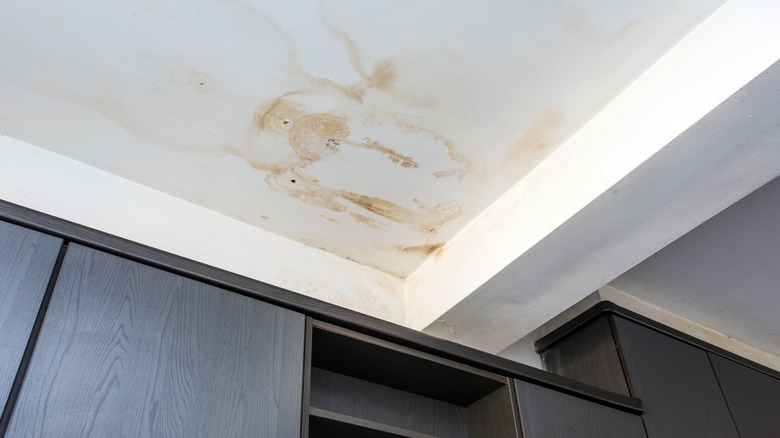What It Could Mean If There Are Water Stains On Your Ceiling
Pipes that bring water to or from the bathroom or kitchen, air conditioning ductwork, and other assets within the walls of your home can be the source of condensation, causing water stains to the visible areas of the house.
Bob Vila reports that stains on the ceiling are often caused by the water evaporating after a leak, meaning that the visible stain is the mineral deposits leftover after the water has dried up. While a ceiling stain may be the first overt sign of a leaking roof, pipes that span the upper section of your home — running out of sight above the ceiling — can carry condensation along their route. They can also drop onto an area of the ceiling after pooling in a chokepoint along the path, via Paramount Restoration.
Cleaning up the after effects of a leak takes on a two-step process. First, you'll need to locate the source of the leak, and then after you've repaired the cause of the discoloration, you should work to rectify the visible stain. Approaching ceiling stains will help you tackle the unsightly blemishes that can appear in a home while also remedying the underlying problem so that the staining doesn't return later on.
Attack the underlying problem for a permanent remedy
Understanding the extent of your problem is the first step when finding a ceiling stain. It's important to act fast because a roof leak can lead to increased volumes of damage over time. Often, these stains result from minor issues that come along with quick fixes, but you won't know until you investigate.
Bob Vila notes that three main culprits often cause these leaks. Upstairs bathrooms require the home to carry water in the space above the lower floor, and a leaking pipe can quickly begin to drip consistently in a location specific to the failure. Bob Vila suggests that this is typically found around old or otherwise faulty caulking.
Leaking can also come from the HVAC system. The ductwork and radiator pass conditioned air that can drastically differ in temperature from the surrounding attic atmosphere. Under the right circumstances, this can lead to a buildup of moisture around specific areas that can drip down into the ceiling components resting directly below the air conditioning equipment.
Finally, a roof leak can also allow water to seep into the attic space above your head, eventually making its way down to the boards that make up the ceiling. Identifying a roof leak early on is essential, and patching tiles or shingles on the outside, shoring up vents, or repairing weatherproofing material will solve the problem. But this can be the first sign of a looming roof replacement.
Clean up the visible stain to complete the fix
After repairing the source of the leak, you can move on to the leftover mildew, grime, or discoloration left behind by the dripping water. It's important to identify the trouble and solve it before clearing the ceiling and returning it to its original look. This is because leaving the problem to fester will only invite a return of the stain at a later date.
Fortunately, these three problems make up the usual suspects, and each one typically presents a solution that many homeowners can tackle on their own. But after the source of the stain has been dealt with, it's time to remove the residue. Cleanipedia recommends a mixture of one part bleach and three parts warm water.
Bob Vila also notes that you should use some essential protective gear when working with bleach. Also, adding a drop cloth to the space beneath the stain will help protect the carpet or tile below from further staining issues resulting from bleach droplets falling off the overhead surface.
Scrubbing the affected area with a cloth soaked in the bleach solution should clear away the remnants of the stain. Then, wiping the surface with a second dry cloth will remove any remaining residue along with the liquid mixture you've applied. Leave the space to dry and then repaint, making sure to use a stain-resisting base coat before painting the ceiling with your color of choice.


